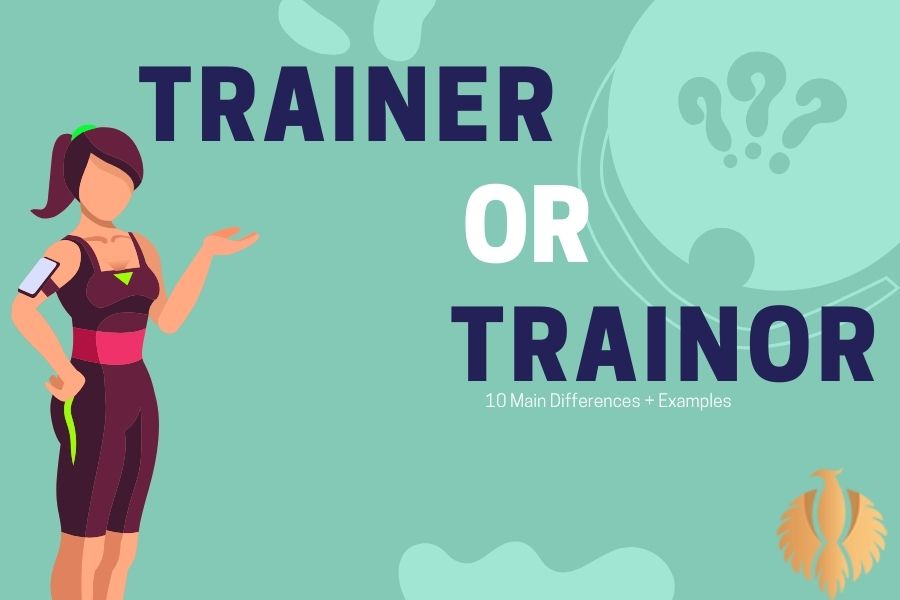In this article, we’re gonna check out the ten main differences between a trainer and a trainor.
Both of these roles are super important when it comes to teaching peeps or groups, but they have different ways of doing things and what they’re responsible for.
Knowing these differences can help organizations and peeps make smart decisions when it comes to training and development stuff.
In this article, we’re gonna check out the ten main differences between a trainer and a trainor.
Understanding these differences is crucial because it helps organizations and individuals make informed decisions about training and development. Whether you’re looking to hire someone to improve your team’s skills or you’re an individual seeking to enhance your abilities, knowing the distinct roles and responsibilities of a trainer versus a trainor can guide you in choosing the right person for the job.
Both of these roles are super important when it comes to teaching peeps or groups, but they have different ways of doing things and what they’re responsible for.
A trainer typically focuses on delivering structured learning experiences, often in a formal setting like a classroom or a workshop. They are experts in their field and use their knowledge to educate others through lectures, demonstrations, and hands-on activities.
Trainers are often responsible for creating lesson plans, developing training materials, and assessing the progress of their learners.
On the other hand, a trainor, while less commonly referred to in this context, can be seen as someone who provides more personalized, one-on-one coaching.
They might work with individuals to develop specific skills or competencies, offering tailored guidance and feedback.
Trainors often take a more flexible approach, adapting their methods to suit the unique needs of each learner.
This role is particularly valuable in settings where customized training is necessary, such as in sports coaching, personal development, or executive coaching.
Knowing these differences can help organizations and people make smart decisions when it comes to training and development stuff.
For instance, if a company needs to roll out a new software system to all employees, a trainer would be the ideal choice to conduct comprehensive training sessions.
Conversely, if an executive needs to improve their leadership skills, a trainor would be better suited to provide the personalized coaching required.
This guide is helpful because it breaks down the key distinctions between trainers and trainors, providing clear examples and practical insights.
By understanding these roles, you can better identify the type of training that will be most effective for your needs.
This is especially important in today’s fast-paced world, where continuous learning and development are essential for staying competitive.
Whether you’re an HR professional, a manager, or an individual learner, this guide will equip you with the knowledge to make informed decisions about training and development.
Key Differences Between Trainers and Trainors
- Definitions and Roles: We will start by defining what a trainer and a trainor are and outlining their primary roles and responsibilities. This section will provide a clear understanding of what each role entails.
- Training Methods: Learn about the different methods used by trainers and trainors. Trainers often use structured, formal methods, while trainors may employ more flexible, personalized approaches.
- Settings and Environments: Discover the typical settings in which trainers and trainors operate. Trainers are often found in classrooms, corporate training rooms, or workshops, whereas trainors might work in more varied environments, including one-on-one sessions or on-the-job training.
- Skills and Expertise: We will highlight the specific skills and expertise required for each role. Trainers need to be adept at curriculum development and group instruction, while trainors must excel in personalized coaching and mentoring.
- Examples and Scenarios: To illustrate the differences, we will provide real-world examples and scenarios where a trainer or a trainor would be the best fit. This will help you see how these roles play out in practical situations.
- Benefits and Challenges: Understand the benefits and challenges associated with each role. This section will help you weigh the pros and cons of hiring a trainer versus a trainor, depending on your specific needs.
- Choosing the Right Fit: Finally, we will offer tips on how to choose the right fit for your training needs. Whether you need a trainer for a large group or a trainor for individual coaching, this guide will help you make the best decision.
By the end of this guide, you will have a thorough understanding of the main differences between a trainer and a trainor.
You will be able to make informed decisions about which type of training professional to hire, ensuring that your training and development efforts are effective and aligned with your goals.
So, let’s dive into this comprehensive guide and explore the fascinating world of trainers and trainors!
which one is right – Trainer or Trainor? What’s the main answer?
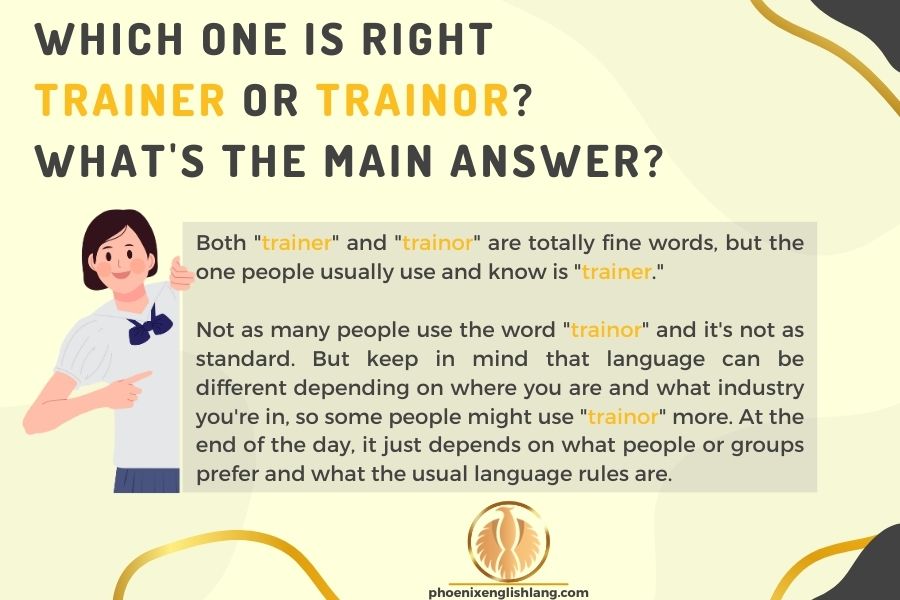
Both “trainer” and “trainor” are totally fine words, but the one people usually use and know is “trainer.” Not as many people use the word “trainor” and it’s not as standard.
But keep in mind that language can be different depending on where you are and what industry you’re in, so some people might use “trainor” more.At the end of the day, it just depends on what people or groups prefer and what the usual language rules are.
You might also enjoy: Only Vs Just All You Need to Know + Examples
1.Definition and Role of Trainer or Trainor

A trainer or trainor is someone who’s responsible for teaching others stuff in a specific field. Their job is to help people learn and reach their goals. Trainers can be found in different industries, like business, education, sports, and personal growth.
They use different methods, such as lectures, demos, hands-on activities, and tests, to make sure people learn well. For example, in a business, a sales trainer might do workshops and role-playing to help employees sell better.
In education, a teacher is like a trainer, giving lessons and guiding students. In general, trainers are super important in giving people the knowledge and skills they need to succeed.
You might also enjoy: Thanks God or Thank God – Fully Explained + Video
2. Examples of Trainer or Trainor

Trainers are like fitness trainers, corporate trainers, and technical trainers and stuff. Fitness trainers do exercises with people, show them how to do it right, and keep an eye on how they’re doing.
Corporate trainers teach stuff about being a leader, being good at talking to people, and giving good customer service. Technical trainers know a lot about specific industries or technologies and teach people about them.
Trainors are like instructional designers, curriculum developers, and training consultants. Instructional designers make online classes, make games for people to play, and make tests. Curriculum developers make big training programs for companies. Training consultants are experts at making training stuff for businesses.
3.Training Delivery
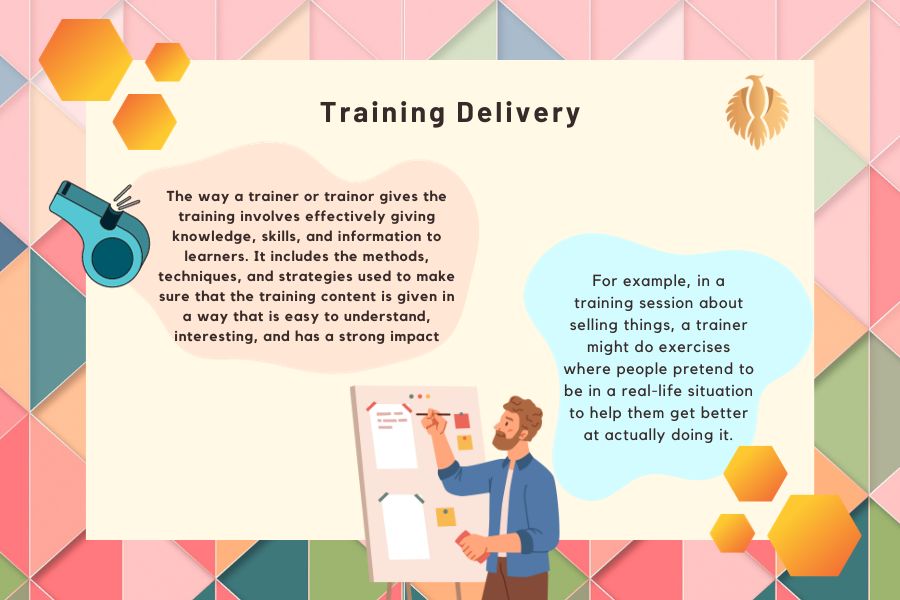
The way a trainer or trainor gives the training involves effectively giving knowledge, skills, and information to learners. It includes the methods, techniques, and strategies used to make sure that the training content is given in a way that is easy to understand, interesting, and has a strong impact.
Trainers or trainors use different ways of giving the training, like talking, showing, doing activities, having discussions, and using things like videos to match different ways that people like to learn.
For example, in a training session about selling things, a trainer might do exercises where people pretend to be in a real-life situation to help them get better at actually doing it. In a classroom, a teacher might use ways of teaching that make the students work together or have debates to make them take part and think for themselves.
The goal of giving the training well is to make a learning environment that is interesting and helps people remember what they learn and get better at doing things.
You might also enjoy: Boys’ or Boy’s– Which One is Correct? + Example
4.Needs Assessment of Trainer and Trainor
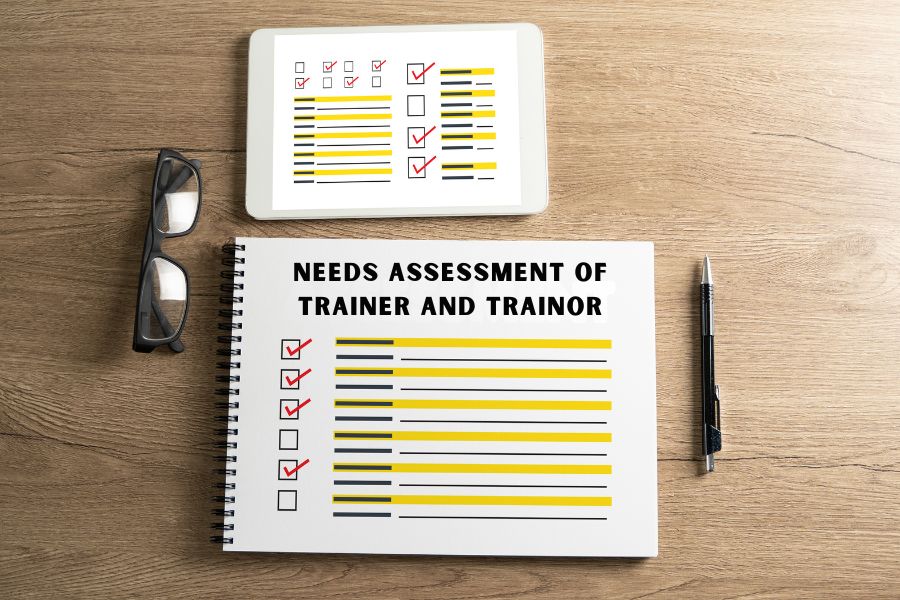
The first step in training is figuring out what people need. This means looking at what they can’t do and what they need to do. By figuring this out, trainers can make programs that help people with their specific challenges and goals. There are different ways to do this, like surveys, interviews, watching people, and looking at how well they do.
For example, in a company, a trainer might talk to employees and managers to see where they need more training, like talking good or being a good leader. In a school, a teacher might test students or talk with them to see what they need help with. By figuring out what people need, trainers can make programs that help people, and make sure they’re good and what people need to learn. This makes training work better.
5. Trainer or Trainor’s Curriculum Development

Curriculum development is super important for trainers or trainors. They gotta make a plan for teaching stuff that’s organized and covers everything. Trainers or trainors look at what their audience wants to learn and figure out a curriculum that matches those goals.
They choose the main topics, what they want their audience to learn, and how they’re gonna teach it. Like, in a leadership training, they might make a curriculum that includes modules on talking well, making decisions, and working in a team. They might also use real-life examples, interactive stuff, and tests to make sure their audience gets a well-rounded learning experience.
Making a curriculum is hard because you gotta really know your stuff, how to teach, and what your audience needs. But if you do it right, you can give a good training program that helps people learn.
6. Instructional Design of Trainer or Trainor

The way a trainer or trainor designs their instruction is all about planning the training program in a smart and organized way to make sure people actually learn something. It includes figuring out what the learners need, making teaching materials, and using good teaching strategies.
Trainers or trainors use these design ideas to make the training content make sense and be easy to follow. They think about things like what the learners should be able to do, how the content is ordered, and how to check if people are learning.
For example, in a software training, the design might be about taking hard ideas and making them small and easy, giving step-by-step directions, and making sure people practice with interactive exercises.
On the other hand, not having a plan can make things confusing and unclear for people. The design of the instruction is super important to make a good training program that fits what the learners need and helps them learn better.
You might also enjoy: Difference Between Ensure VS Make Sure [2023]
7. Evaluation and Assessment

Evaluation and assessment are super important parts of the trainer or trainor’s job in making sure the training program works well and is successful. Evaluation means collecting and analyzing data in a organized way to see how the training is going overall.
This can be done in different ways like surveys, feedback forms, watching, and tests. The trainer or trainor looks at how the learners are doing, figures out what needs to be better, and sees if the learning goals are being met. For example, in a fitness training program, the trainer might check how fit the participants are before and after the training to see if the program is working.
Assessment, on the other hand, is all about seeing how well the learners understand and can do what they’re being taught. This can be done with quizzes, tests, showing what they know, or skill-based evaluations. For example, in a language training session, the trainer might have the learners talk or write to see how well they can use the language.
By doing evaluation and assessment together, trainers or trainors can get really useful feedback, find out what needs to be better, and make changes to make the training better and make sure the learners are learning what they want to learn.
The design of a trainer or trainor is all about planning the training program in a way that makes sure people actually learn something. It involves analyzing what the learners need, making materials for them, and using strategies that work. The trainers or trainors use design principles to organize the content in a logical way.
They think about things like what they want people to learn, how to organize the information, and how to test if people are actually learning. For example, in a software training program, the design might involve breaking down complicated ideas into smaller parts, giving step-by-step instructions, and doing interactive activities to help people learn.
On the other hand, if the design isn’t organized well, people might get confused and not understand anything. The design is really important because it makes sure the training program is well-structured and effective for the learners.
8.Continuous Improvement of Trainer or Trainor

Evaluation and assessment are really important for trainers or trainors to make sure the training program works well. Evaluation means collecting and analyzing data to see how the training is going.
This can be done in lots of ways, like asking people questions, observing them, or testing how well they’re doing. The trainer or trainor looks at how well people are doing, figures out what needs to be better, and sees if the learning goals are being met. For example, in a fitness training program, the trainer might check how fit people are before and after the training to see if it worked.
Assessment, on the other hand, is all about testing how well people understand the training. This can be done with quizzes, tests, or seeing people do things for real. For example, in a language training session, the trainer might do tests or listen to people speak to see how well they know the language. By doing evaluation and assessment, trainers or trainors can get feedback, see what needs to be better, and make changes to make the training better and make sure people learn what they’re supposed to.
Being a trainer or trainor means always trying to make things better. This means always looking for ways to improve how they do things, what they teach, and how they teach it to make sure people learn the best they can.
There are lots of things trainers or trainors can do to make things better. One thing they can do is to stay updated on what’s going on in their industry. By knowing what’s new, they can include new information in their training. For example, a technology trainer might go to conferences or workshops to learn about new software updates and use them in their training materials.
Another example is when trainers ask learners for feedback. They can do this through surveys, evaluations, or just talking openly with the learners. The trainers want to know what they are doing well and what they need to work on. This feedback is important because it helps the trainers figure out what they need to change.
For example, a language trainer might ask the learners how they feel about different teaching methods and then adjust their approach based on the feedback. Trainers can also look at recordings of their training sessions or ask for advice from more experienced trainers to see how they can improve. By doing this, trainers can figure out where they need to get better. Trainers can also go to workshops or seminars to learn more.
For instance, a leadership trainer might take a course on how to communicate better or build a stronger team. In conclusion, trainers need to always be getting better. They need to stay up to date with what’s happening in their industry, get feedback from learners, think about how they can improve, and keep learning new things. When trainers do all of this, they can provide better training sessions that really help the learners.
9.Training Program Management
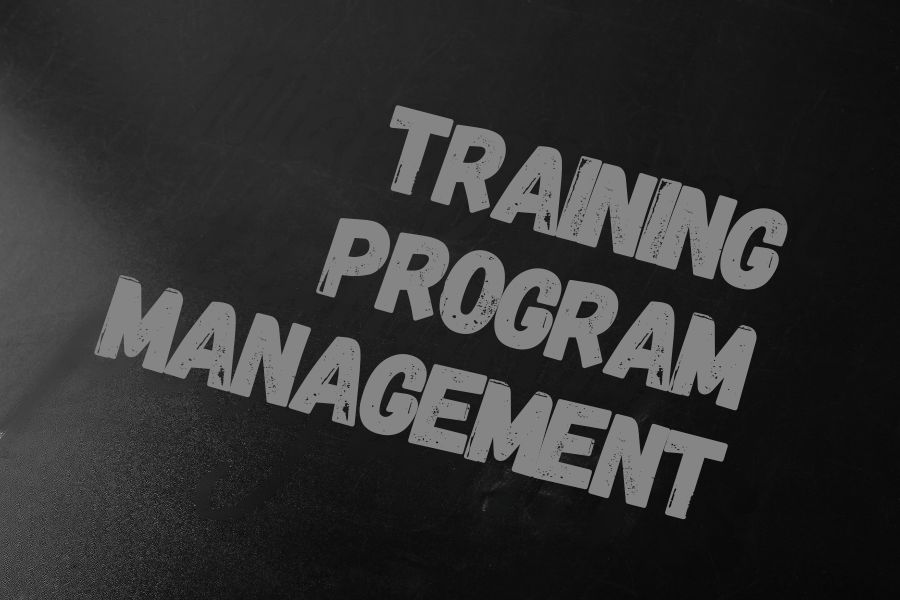
Training program management is like the boss of a training program. They make the plan, organize everything, and make sure it all goes smoothly. They figure out what the program should look like, set goals, pick who should be in it, schedule sessions, and make sure everything runs well.
The trainer or trainor is in charge of all this, and they also have to take care of the resources, make sure everything is organized, and see if the program is working. They might also have to figure out what the learners need, make training materials, and see how everyone is doing.
For example, in a corporate training program, the trainer might do everything from figuring out what’s needed to making the schedule and seeing how it all turns out. When we compare training delivery and training program management, we can see that delivery is all about actually giving the knowledge and skills to the learners.
Program management is bigger – it’s all about making plans, organizing, and seeing how the whole program is doing. Both are important for a good training experience. Delivery is about the trainer and learners working together, and program management is about making sure everything is good and fits the learners and the organization. Both need to happen for a training program to work well.
You might also enjoy: Have Vs Had: Complete Grammatical Guide [2023 Method]
10. Expertise and Qualifications of Trainer or Trainor with Examples

Trainers or trainors have a mix of know-how and qualifications that let them teach others stuff. They usually get their know-how from knowing a lot about a certain topic or field. This helps them give useful insights, examples, and real-life applications to make learning better.
The qualifications for trainers can be different depending on the industry they specialize in. Many trainers have degrees or certifications that show they know their stuff. For example, an IT trainer may have a degree in computer science or certifications like Cisco Certified Network Associate (CCNA) or Microsoft Certified Solutions Expert (MCSE).
These show that they know their stuff when it comes to teaching IT. Besides the formal stuff, trainers also have hands-on experience from working in their field for a long time. They bring real-life situations and problems into their training sessions to make learning more interesting and useful.
For example, a trainer in the hospitality industry may have worked in hotels or restaurants and knows a lot about customer service, operations, and management. This helps them give good advice and tips to trainees. Good trainers also have strong communication and people skills.
They can explain complicated things in a simple way and change how they teach to suit their audience. They make a friendly and inclusive environment for learning, and they encourage everyone to take part and talk openly. Skilled trainers can also motivate and inspire learners, helping them overcome challenges and reach their goals.
There are lots of examples of trainers in different industries. In fitness, a certified personal trainer may have a degree in exercise science and certifications from organizations like the American Council on Exercise (ACE) or the National Academy of Sports Medicine (NASM).
They know a lot about making personalized workout plans, giving advice on food, and teaching safe and effective exercise techniques. In the business world, trainers who teach leadership and management may have fancy degrees in business administration or organizational psychology.
They may also have certifications like the Project Management Professional (PMP) or the Certified Professional in Learning and Performance (CPLP).They know a lot about building teams, solving problems, and making plans. So, trainers or trainors have a mix of know-how and qualifications.
They know their stuff in a certain field, and they have the education and experience to teach it well. They’re also good at talking to people and making learning interesting. Whether it’s fitness or business or anything else, trainers are important for helping people learn and succeed.
Conclusion
Understanding the diff between trainers and trainors is super important for orgs and peeps in training and development. Trainers are all about giving info and helping peeps learn, while trainors are more about coming up with and making training programs. Both roles are hella important for good training results and making training stuff successful overall.

Hi, welcome to my blog! My name is Omid and I am thrilled to have you here! I am an English language teacher with 12 years of experience and hold multiple international certifications (TESOL, IELTS, TOEFL, PTE, CELTA). Additionally, I hold a PhD in Applied Linguistics with a specialization in Teaching English as a Second Language (TESL), which fuels my passion for teaching English and assisting others in mastering the language. To me, nothing is more rewarding than helping individuals enhance their English language abilities through various methods. So, let’s embark on this journey of learning English together.

